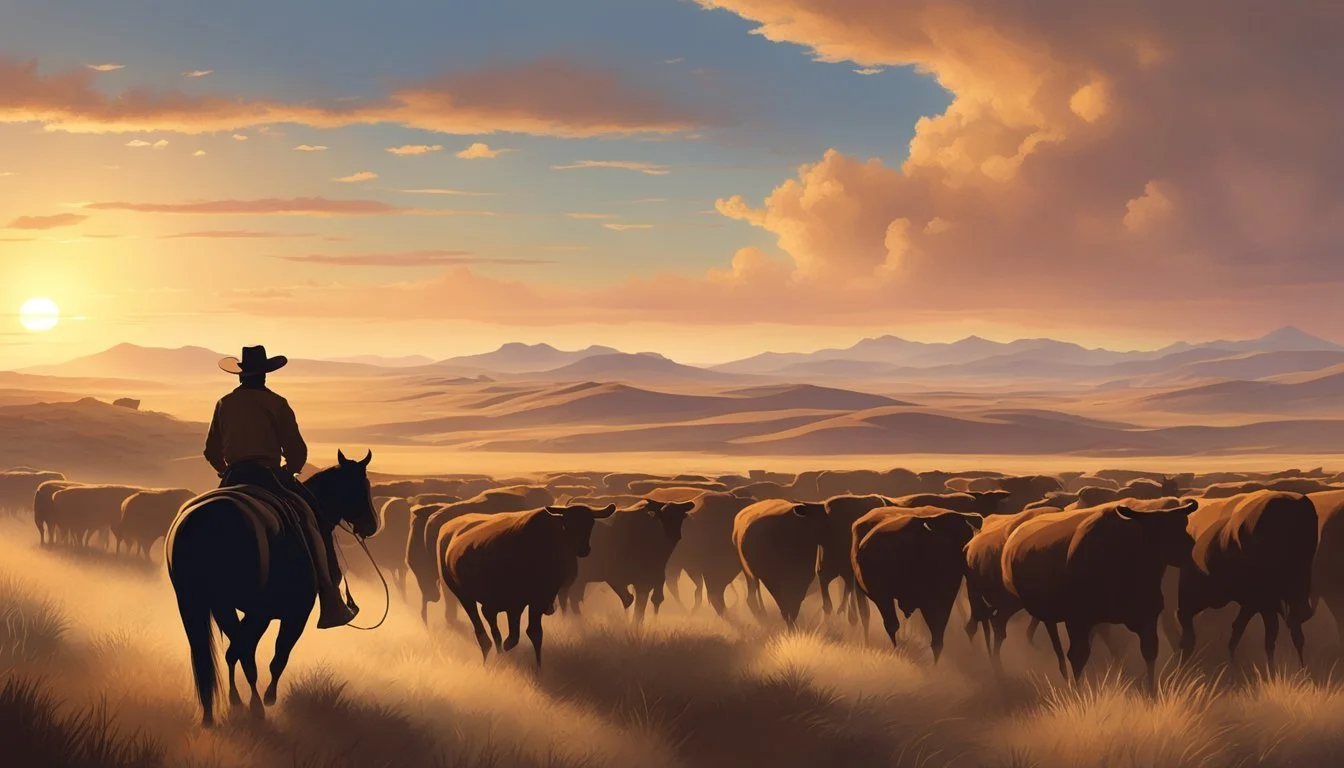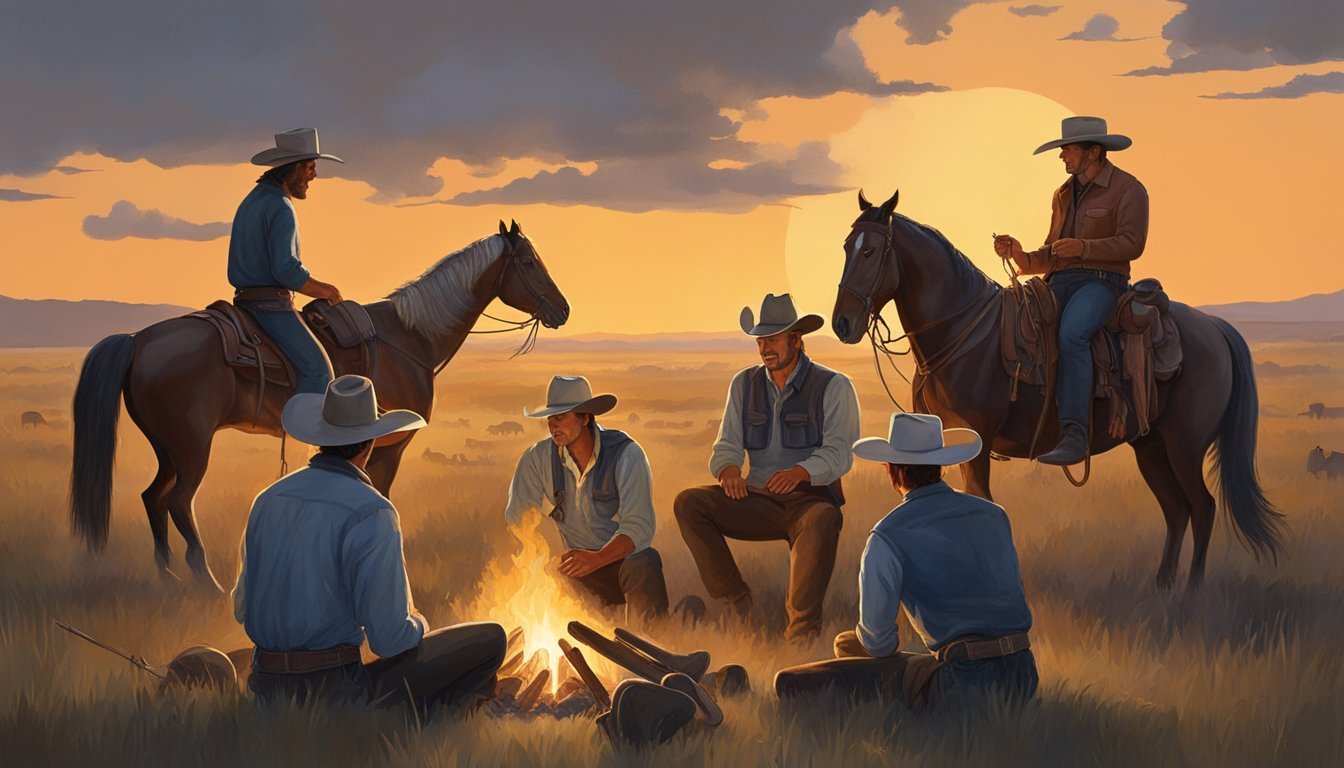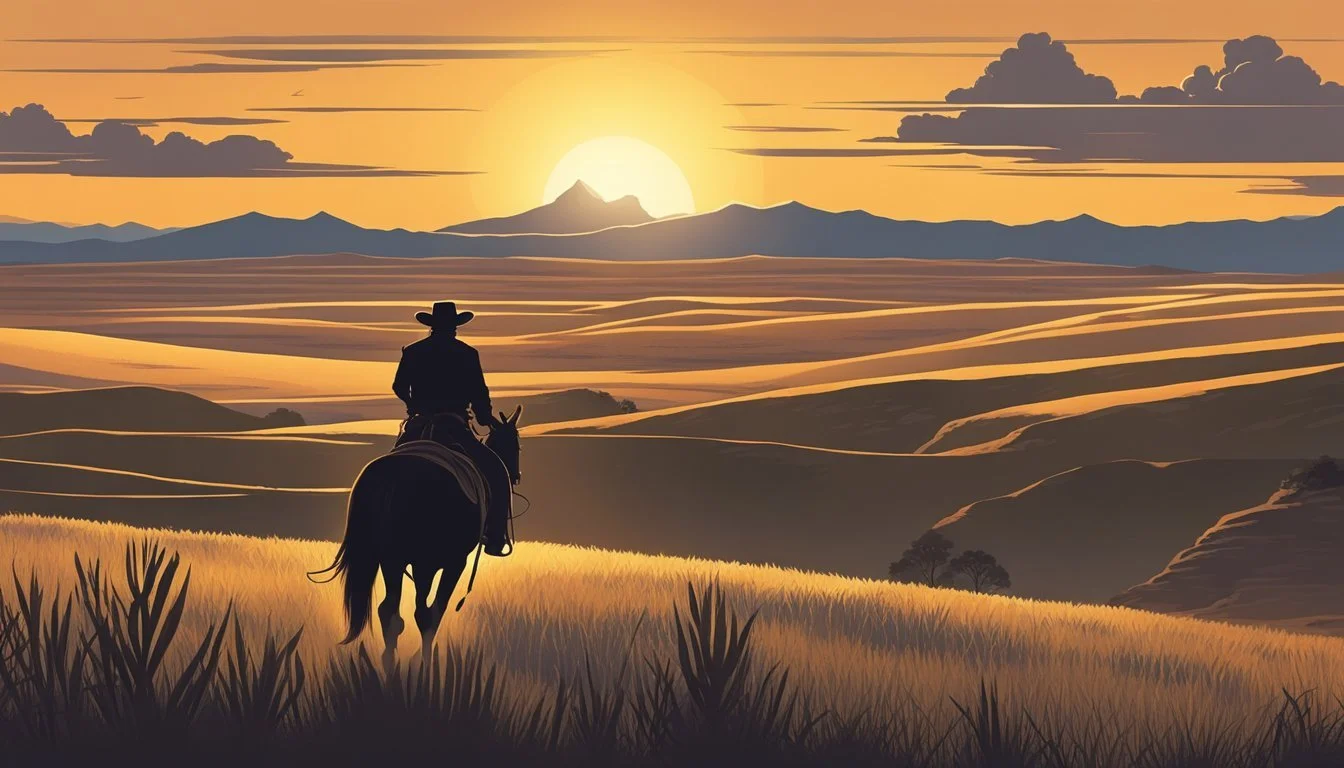The Legendary Figures of Texas Cowboy Lore
Icons and Tales from the Old West
The image of the Texas cowboy stands as one of the most enduring and iconic symbols of the American West. These rugged individuals became the emblem of a life led on the open range, where the cattle industry flourished and demanded a particular set of skills and tenacity. Texas, with its vast landscapes and challenging environment, was a crucible in which the archetypal American cowboy was forged. They embodied the virtues of courage, independence, and resilience, becoming central figures in the folklore and history of the region.
Legends such as Pecos Bill personify the grandiose nature of cowboy tales, weaving the everyday life of cattle driving with fantastical elements. Although Pecos Bill is a fictional character, his stories capture the essence of the cowboy spirit that Texas is known for. Cowboys in Texas were more than just cattle herders; they were trailblazers and horsemen who played a significant role in pioneering the Western frontier. Their lifestyle was a response to the practical needs of the time, as in the 1870s and 1880s, when long cattle drives to railheads in Kansas were common.
Such historical narratives and folk heroes symbolize the grandiosity of the West during the period of westward expansion. The stories of cowboys and outlaws alike have been etched into the collective memory, often romanticizing the lawlessness of the Wild West. Nevertheless, the essence of these accounts lies in their celebration of key values and the cultural legacy left behind by the Texas cowboys, whose influence extends far beyond the boundaries of the Lone Star State.
History of Texas Cowboys
The history of Texas cowboys is anchored in the emergence of the cattle industry and is a definitive aspect of the American West narrative. These cowboys were central to shaping what is known as the cowboy way of life in the Old West following the Civil War.
Early Origins and Vaqueros
Vaqueros, the original cowboys of Texas, were skilled horsemen who originated from Spanish colonial stock. They brought early cattle ranching techniques to the region in the 18th century, setting the foundation for future cowboy culture.
Cattle Industry Expansion
With the expansion of the American frontier, Texas became a hub for the cattle industry. The demand for beef in the East led to the growth of the cattle drives, which were often manned by young men seeking work after the Civil War.
Post-Civil War Era
The Post-Civil War era saw an influx of demand for Texas cattle, which created the need for long cattle drives. Many former Confederate soldiers found employment as cowboys, driving herds of cattle to railheads in Kansas.
Golden Age of the Cowboy
The Golden Age of the Cowboy was a period in the late 19th century when the cowboy lifestyle reached its peak. The image of the cowboy became synonymous with Texas and the American West, embodying the spirit of the Old West and the American frontier.
During this era, cowboys drove millions of cattle along trails from Texas to railheads where the stock was shipped East. This golden age lasted until the late 1880s, when barbed wire, railroads, and settlement began to end the era of the open range.
Legendary Figures of the Cowboy Era
During the late 19th century, the American West was home to a colorful tapestry of individuals, from the notorious outlaws to the revered lawmen, intrepid ranchers, and performers who became household names. Their real and embellished exploits continue to shape our understanding of this period in history.
Outlaws and Lawmen
Billy the Kid, once a deadly gunfighter, is one of the era's most infamous outlaws. Born Henry McCarty, he claimed the lives of eight men before his premature death at 21. His story is often intertwined with famed sheriffs and Texas Rangers who attempted to uphold the law during these tumultuous times.
Jesse James
Profession: Outlaw
Notoriety: Bank and train robberies
Legend: Embodied the rebellious spirit of the era
Wyatt Earp
Roles: Lawman, gambler, buffalo hunter
Fame: Gunfight at the O.K. Corral
Legacy: Embodies the image of the steadfast Western sheriff
Famous Ranchers and Cowboys
Widely revered and sometimes romanticized, cowboys and ranchers were the backbone of the cattle industry, and some became legends in their own right. They managed vast herds across state lines, showcasing skills that made them central to cowboy lore.
Innovation: Inventing bulldogging (steer wrestling) in rodeo
Impact: African American cowboy icon
Wild West Show Icons
Buffalo Bill Cody and Annie Oakley became international stars through their participation in the traveling Wild West Shows. They brought a romanticized, yet highly popular, version of Western life to audiences around the globe, creating legends through performance.
Buffalo Bill Cody
Achievements: Scout, buffalo hunter, Wild West Show impresario
Contributions: Popularized tales of the West
Annie Oakley
Skill: Sharpshooting
Role: Star in Buffalo Bill’s Wild West Show
Recognition: A symbol of the capable Western woman
These figures, among others, painted a vivid picture that captures the imagination and the spirit of an era defined by grit, lawlessness, spectacle, and the pursuit of freedom and prosperity in the Wild West.
Culture and Lifestyle
The Texas cowboy is synonymous with resilience and a unique cultural identity shaped by a history of diverse influences and a demanding lifestyle.
Daily Life and Hard Work
Daily Routines: The life of a cowboy in Texas was characterized by long, hard work days starting before dawn and ending after dusk. Cowboys were responsible for a variety of ranch duties, such as:
Herding cattle
Repairing fences
Handling horses
Branding livestock
Their expertise in horsemanship and cattle management was crucial to the ranching operations that dominated the Texan economy during the settlement of the wild frontier.
Rodeos and Entertainment
Rodeo Origins: Rodeos emerged from the practical skills cowboys used during roundups and cattle drives. They soon became a form of entertainment and competition, celebrating the cowboy's role in Texan culture.
Competitive Events: Traditional events include bronc riding, steer wrestling, and roping.
Community Impact: Rodeos served not only as entertainment but also as a means of fostering community among ranchers and cowboys.
Cultural Influence and Folklore
Cowboy Influence on Texan Identity: Cowboys left a lasting impact on the arts, music, and folklore of Texas.
Songs and Literature: Their tales became the stuff of legend, inspiring countless songs and stories.
Visual Arts: Cowboys and their lifestyles have been a rich subject for artists, capturing the essence of Texas’s heritage.
Folklore: Myths and larger-than-life figures like Pecos Bill emerged from the cowboy era, blending the lines between real and fantastical elements of Texan history.
Challenges and Resilience
In the fabric of Texas cowboy lore, the legendary figures were defined not just by their skills but also by their tenacity to overcome challenges. From the perilous cattle drives to conflicts that shaped the West, their resilience remains a testament to the era.
Cattle Drives and Herding Challenges
Cattle drives were foundational to the cattle industry, marking a period where cowboys showcased their herding prowess. Key challenges included:
Navigation: Finding the best routes to avoid natural hazards.
Weather: Severe storms could scatter herds and delay progress.
Advancements such as the widespread use of barbed wire brought an end to the era of the open range, significantly changing the dynamics of herding and cattle management.
Conflict with Native Americans
Clashes with Native American tribes were frequent as cowboys drove cattle across lands that native people inhabited or used for hunting. Encounters ranged from:
Peaceful trade dealings to negotiate safe passage.
Violent confrontations that could result from trespass or misunderstanding.
Outlaw Threats and Law Enforcement
The rise of outlaws posed a constant threat to the livelihood of cowboys and ranchers. Issues like cattle rustling and train robberies were prevalent, with notorious incidents like those in Lincoln County spotlighting the criminal element of the period. Law enforcement's response included:
Tightening security: With sheriffs and posses chasing down outlaws.
Legal frameworks: Developing laws to better protect assets and lives.
Evolution of Cowboy Identity
The Texas cowboy's identity has transitioned from the practical needs of cattle drives to the flamboyant representations in rodeos and Wild West shows, reflecting a complex combination of tradition, popular culture, and evolving societal roles.
From Cattle Drives to Rodeos
Cattle drives were the cornerstone of cowboy culture, originating in the 1800s when Texas cowboys drove herds of cattle across vast landscapes to marketplaces. They demonstrated a unique set of skills such as horsemanship, roping, and managing cattle herds. These treks were fraught with adventure and danger, establishing the cowboy’s identity as one of resilience and resourcefulness.
Transitioning from the necessity of cattle drives, rodeos became a venue where the public could witness the cowboys' skills in a competitive arena. Rodeos transformed the cowboy culture into a spectator event, celebrating the traditional tasks of the drive while contributing to the cowboy's iconic status in popular culture.
Influence of Wild West Shows
Wild West shows played a pivotal role in mythologizing the cowboy identity. They dramatized the exploits of Texas cowboys and often exaggerated their adventures, solidifying a romanticized image of the cowboy in the American imagination. The shows, characterized by their theatrical performances, included reenactments of cattle drives and showcased a stylized version of cowboy life that significantly impacted popular culture.
These traveling performances led by figures like Buffalo Bill Cody not only entertained but also perpetuated a specific perception of the cowboy as a valorous and adventurous figure emblematic of the American spirit.
Transition to Modern Day
The cowboy identity has continued to evolve from working cattle to becoming a cultural icon. In modern times, the cowboy symbolizes both the historical significance and the continued allure of Wild West imagery. They remain a fixture in Texas identity, though today's cowboys may work on ranches or compete in professional rodeo circuits.
Cowboys have also influenced various aspects of popular culture, from fashion to film, perpetuating both authentic and fictionalized narratives. Despite the transformations over time, the core attributes of the cowboy — self-reliance, hard work, and a spirited sense of adventure — continue to resonate within cowboy culture.
Notable Biographies and Memoirs
The rich tapestry of Texas cowboy lore is reflected in the many autobiographies and historical accounts that capture the lives, adventures, and culture of the legendary figures from the Lone Star State. These writings not only document the personal experiences of cowboys and outlaws but also offer scholarly analysis, providing a multifaceted view of the Wild West.
Autobiographies of Cowboy Legends
"A Texas Cowboy" by Charles A. Siringo stands as a seminal autobiography providing a firsthand account of a cowboy's life in the late 19th century. Siringo's narrative encompasses the full spectrum of cowboy experiences, from roundups and trail drives to encounters with outlaws like Billy the Kid.
Another significant memoir is the life story of John Wesley Hardin. Known equally for his exploits as a cowboy and his life of crime, Hardin's autobiography provides an intimate look into the life of one of Texas' most notorious gunslingers, allowing readers to explore themes of murder and love from the perspective of a man often identified with the wild aspects of cowboy lore.
Historical Accounts and Analysis
Historical analysis of cowboy memoirs often intertwines with the work of detectives, such as those from the Pinkerton Detective Agency, giving insights into law enforcement in the Wild West. Accounts such as "The Expressman and the Detective" by Allan Pinkerton delve into the detective's experiences chasing outlaws and provide a distinct contrast to the narratives of cowboy legends.
Scholars have also contributed biographical accounts of these figures, offering comprehensive and critical examinations. For instance, the biographies of lawmen who operated during the cowboy era often include analyses of famous figures and their impact on the myths of the Texas West.
Through these biographies and memoirs, readers gain access to a range of narratives that recount the rugged life of the Texas cowboy, the complexity of frontier justice, and the personal memoirs of those who either enforced the law or lived outside it. These accounts are as diverse as the state of Texas itself, each contributing to the enduring legacy of its cowboy heritage.
Impact on Popular Culture
The legendary Texas cowboy has left an indelible mark on popular culture, influencing a range of media from films and television to literature and music. These representations often echo the distinctive identity and storied past of the American cowboy, intertwining myth, tales, and history.
Representation in Film and Television
The cowboy archetype has been a mainstay in film and television, often portrayed as a rugged, self-reliant figure embodying the spirit of the Wild West. Westerns rose to prominence as a genre that celebrated this ideal, crafting narratives around the lives, challenges, and adventures of cowboys. Noteworthy television series like "Gunsmoke" and "Bonanza" brought cowboy stories into living rooms, solidifying their place in American culture.
Cowboys in Literature and Music
Literature has played a pivotal role in shaping the cowboy legend, with pulp novels and dime stories magnifying their exploits. The oral tradition, too, contributes to popular culture through ballads and cowboy poetry, keeping the cowboy's legacy alive. In music, genres such as country and folk often reflect the cowboy's influence through songs that speak of the open range, a sense of freedom, and cowboy culture.
Cowboy Arts and Artifacts
Authentic cowboy arts and artifacts are a testament to the everyday life and identity of cowboys. From saddlery to roping, these functional items have become collectible symbols of the cowboy era. Museums and collectors preserve items like spurs, chaps, and belt buckles, which are steeped in the culture and superstitions of Texans and the West at large.
Preserving the Legacy
The preservation of the Texas cowboy legacy is a multifaceted endeavor, encompassing education on western heritage and the curation of artifacts in museums. These efforts ensure that the revolutionary impact of cowboys on American history and culture remains accessible and influential for future generations.
Western Heritage and Education
Educational initiatives focus on explicating the cowboy’s role in shaping the West. Organizations dedicate resources to teaching about historical trails like the Goodnight-Loving Trail, which played a significant role in cattle drives. They shed light on legendary figures like Buffalo Bill, whose Wild West shows broadcasted the cowboy ethos and stories, embedding them in the fabric of American culture. These stories, rich with cultural significance, are transmitted through various educational programs and authentic reenactments, ensuring that the essence of cowboy culture is sustained.
Museums and Historical Societies
Museums and historical societies play a pivotal role in preserving cowboy heritage by housing vital artifacts and conducting scholarly research. For example:
The Black Cowboy Museum in Texas works to preserve the legacy of Black cowboys' influence on Western culture.
Historical societies across Texas have amassed extensive archives that chronicle the cowboy’s journey and its indelible mark on American history.
By displaying relics and recounting tales of the pioneering spirit of Texas cowboys, these institutions solidify the state's deep connection to its Western roots and its monumental impact on the broader tapestry of American heritage.
Contemporary Cowboy Figures and Events
The contemporary Texas cowboy sustains the legacy of the Wild West through modern rodeos and a vibrant ranch culture that celebrate the skills, resilience, and independence central to the American cowboy ethos.
Modern Rodeos and Competitions
Rodeos have evolved from practical cattle herding tasks into electrifying competitions showcasing cowboy skills. Modern rodeos, such as the famed Houston Livestock Show and Rodeo, see cowboys and cowgirls participate in events like bull riding, steer wrestling, and team roping. These events not only honor traditional cowboy practices but also serve as significant cultural gatherings, echoing the communal spirit of Texas.
Key Rodeo Events:
Bull Riding
Barrel Racing
Steer Wrestling
Team Roping
Saddle Bronc Riding
Competitors often don attire that pays tribute to historic cowboy fashion, complete with stylized hats and boots, enhancing the cultural immersion for spectators.
Living Cowboys and Ranch Culture
Despite modern advancements, ranch life in Texas remains firmly rooted in the heritage of the cattle industry. Cowboys today manage herds, preserve open-range practices, and maintain the integrity of America's beef supply. Ranches, such as the 6666 Ranch, act as living museums of the cowboy lifestyle, fostering a connection to the land and animals under their stewardship.
Modern Cowboy Tasks:
Cattle herding
Horse breaking
Fence mending
Land management
This enduring culture is characterized by a deep-sent appreciation for tradition and an unwavering spirit of independence and resilience that defines the Texas cowboy.
Conclusion
The cowboy is an indelible icon of Texas and the American West. This character did not arise in isolation but rather as part of a tapestry of stories and cultures that have shaped the state's identity. The lore surrounding cowboys is not simply a collection of tall tales, but a fusion of reality and myth, which provides an understanding of the values and experiences of those who lived through the West's formative years.
Cowboy lore reflects a variety of legendary figures, united by a common spirit of resilience and independence. From their origins with the vaqueros to the cowhands of cattle drives, these individuals embodied the virtues of bravery and self-reliance. Texas, in particular, has been a cornerstone in the preservation of this heritage, its vast landscapes providing the backdrop to countless narratives of cowboy life.
The reach of cowboy stories extends far beyond the borders of Texas. Through cowboys and their exploits, aspects of cultural significance have woven their way into the fabric of American identity. These range from the representation of cowboys in literature and film to the influence on contemporary values of individualism and perseverance.
The following are critical aspects that cowboy lore in Texas has imparted to American culture:
Respect for hard work and horsemanship
Celebration of open-range life and freedom
Contributing to the mystique of the "Wild West"
Texas cowboy lore, vibrant and enduring, continues to capture the imagination, providing insights into the past and leaving a profound impact on American culture and storytelling.











